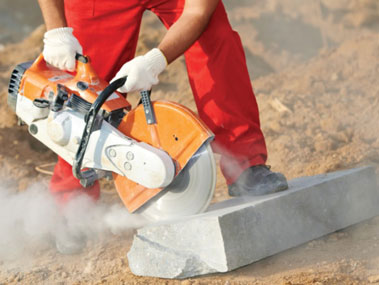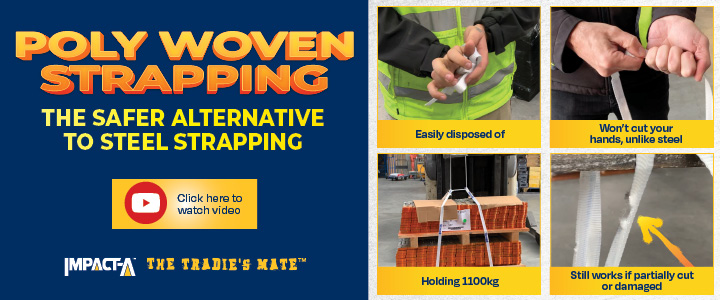A rising number of cases of silicosis on major construction sites and among stonemasons has prompted the call for the urgent education of workers about exposure to crystalline silica dust.
By Cameron Cooper
Certified occupational hygienist Kate Cole recalls watching construction workers hosing the air on one site in an effort to reduce the threat of crystalline silica dust exposure.
It is a moment that highlights the misconceptions and lack of onsite knowledge about how to better manage the threat of silicosis—a serious and potentially fatal respiratory disease—among construction workers and tradespeople who work with engineered stone.
“That’s completely useless and shows that they haven’t got the right level of expertise to keep themselves safe,” says Cole, an engineer who has worked in the construction industry for almost two decades. “Young workers, in particular, think ‘Oh, it’s just a bit of dust’ and they don’t understand that in 20 years’ time it could result in an early retirement, or an unfortunate early loss of life.”
Cole is one of a growing band of industry and government champions who are educating construction workers about the risks of silicosis and developing governance processes to create safer workplaces.
The Australian Government’s National Dust Disease Taskforce released a report in 2021 (see panel on the next page) stating that there is a critical need for urgent action to further protect workers in the engineered stone industry, in particular, who cut and install kitchen benchtops. There is also growing awareness of health risks on construction, infrastructure, mining and demolition sites.
“The challenge really is to help raise awareness and provide education to the workforce,” Cole says.
WHAT IS SILICOSIS?
Silicosis results in a scarring and hardening of lung tissue after silica dust particles are inhaled and become embedded in lungs. The disease can be progressively debilitating and fatal.
On construction sites, workers can be easily exposed to silica when tunneling, drilling, crushing or blasting rock that contains silica or concrete and masonry products. These minute particles have a far smaller diameter than a human hair.
In addition to silicosis, exposure to silica dust is often associated with workers getting other illnesses such as chronic bronchitis, emphysema and lung cancer. In most cases, the condition develops over 10 to 20 years, but in acute cases high exposure to silica dust can lead to the onset of the disease within a year or so.
The Australian Workers’ Union suggests that about 600,000 workers are exposed to silica dust every year, with about 350 diagnosed with silicosis and 250 with lung cancer.
Exposure to silica dust is a nationwide problem. Cole says Sydney, in particular, presents a risk because it sits on a basin of Hawkesbury sandstone, which has high concentrations of quartz, which produces very fine dust particles when cut or disturbed. In Brisbane, the host rock, tuff, is formed from volcanic eruptions and also produces fine dust particles. Mining sites in other states also come with high risks.
PREVENTATIVE MEASURES
Education is the key to addressing the silicosis risk, according to Cole. Even when workers get a construction site White Card, of if they train at TAFE or study engineering at university, there is typically no mention of silica dust risks or safety measures.
“You’re just not taught about it,” she says. “We really need to fix this because we have young workers coming into the infrastructure sector—which is a wonderful place to work—but the first time they hear about silicosis is in a site induction, if they’re lucky. That’s just not good enough.”
While larger construction companies typically manage silica dust exposure quite well, the level of awareness often is not sustained among smaller contractors and sub-contractors down the project chain.
A range of actions can help mitigate the risk of silica dust exposure, including:
- insisting on pre-project planning to eliminate or control dust and organising appropriate ventilation of sites
- use of on-tool water suppression of dust to contain the hazard and protect adjacent workers
- conducting regular air monitoring of sites
- provision of adequate PPE gear for workers
- proper ‘fi t testing’ of masks to ensure they are the right size for each worker
- showering and changing clothes before leaving a site to prevent contamination of cars and homes
- provision of ongoing medical checks and health surveillance of workers
“A lot of it comes down to the employers,” Cole says. “It’s one thing to provide training to your workers on the hazards of silica dust, but you need to provide a safe working environment. And that requires more than just providing a dust mask.”
The positive news is that she has seen appropriate safety measures successfully being applied to many construction sites. “It can be done, but it does take eff ort and planning,” Cole says.
NATIONAL ACTION PLAN
One initiative that is crucial is the promise by the Department of Health to lead the development of a National Silicosis Prevention Strategy and a National Action Plan.
Different approaches are adopted across each state, but some are forging ahead. Victoria, for example, released new regulations in 2021 on silica dust control. “In Victoria, for the first time in our country’s history, we have regulation that specifically calls out the particular risks associated with tunneling, which is great,” Cole says. “But we need nationally consistent regulation that addresses workers in the infrastructure, construction and demolition sectors.”
In addition to more training, Cole says the key to future success in tackling silicosis risks will be around compliance with any regulations that are introduced.
“It’s one thing to have a workforce exposure standard, but it’s a different thing to ensure that companies comply with the rules.”






